Sari
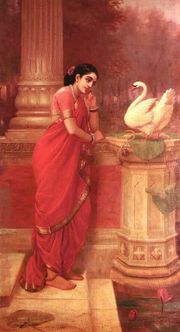
A sari or saree (Bengali: শাড়ি shaṛi, Hindi: साड़ी sāṛī, Kannada: ಸೀರೆ, sīre, Malayalam: സാരി sāri, Marathi: साड़ी sāṛī, Nepali: सरि sari, Punjabi: ਸਾਰੀ sārī, Tamil: புடவை puṭavai, Telugu: చీర cīra, Urdu: ساڑى sāṛī) is a strip of unstitched cloth, ranging from four to nine metres in length that is draped over the body in various styles.[1] It is popular in India, Nepal, Bangladesh, Pakistan, Sri Lanka, Bhutan, Burma, and Malaysia. The most common style is for the sari to be wrapped around the waist, with one end then draped over the shoulder baring the midriff.[1]
The sari is usually worn over a petticoat (लहंगा lahaṅgā or "lehenga" in the north, pavada/pavadai in the south, chaniyo in the west, and shaya in eastern India), with a blouse known as a choli or ravika forming the upper garment. The choli has short sleeves and a low neck and is usually cropped, and as such is particularly well-suited for wear in the sultry South Asian summers. Cholis may be backless or of a halter neck style. These are usually more dressy with plenty of embellishments such as mirrors or embroidery, and may be worn on special occasions. Women in the armed forces, when wearing a sari uniform, don a short-sleeved shirt tucked in at the waist. The sari developed as a garment of its own in both South and North India at around the same time, and is in popular culture an epitome of Indian culture.[2]
Contents |
Origins and history
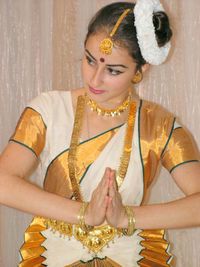
The word sari is derived from Sanskrit शाटी śāṭī[3] which means 'strip of cloth'.[4] This became शाडी śāḍī or साडी sāḍī in Prakrit, and then sāṛī in Hindi.[5]
In the history of Indian clothing the sari is traced back to the Indus Valley Civilisation, which flourished during 2800-1800 BCE around the western part of the Indian subcontinent.[1] The earliest known depiction of the sari in the Indian subcontinent is the statue of an Indus Valley priest wearing a drape.[1]
Ancient Tamil poetry, such as the Silappadhikaram and the Kadambari by Banabhatta, describes women in exquisite drapery or sari.[6] In ancient Indian tradition and the Natya Shastra (an ancient Indian treatise describing ancient dance and costumes), the navel of the Supreme Being is considered to be the source of life and creativity, hence the midriff is to be left bare by the sari.[7]
Sculptures from the Gandhara, Mathura and Gupta schools (1st-6th century AD) show goddesses and dancers wearing what appears to be a dhoti wrap, in the "fishtail" version which covers the legs loosely and then flows into a long, decorative drape in front of the legs. No bodices are shown.[8]
Other sources say that everyday costume consisted of a dhoti or lungi (sarong), combined with a breast band and a veil or wrap that could be used to cover the upper body or head. The two-piece Kerala mundum neryathum (mundu, a dhoti or sarong, neryath, a shawl, in Malayalam) is a survival of ancient Indian clothing styles. The one-piece sari is a modern innovation, created by combining the two pieces of the mundum neryathum.[9]
It is generally accepted that wrapped sari-like garments, shawls, and veils have been worn by Indian women for a long time, and that they have been worn in their current form for hundreds of years.
One point of particular controversy is the history of the choli, or sari blouse, and the petticoat. Some researchers state that these were unknown before the British arrived in India, and that they were introduced to satisfy Victorian ideas of modesty. Previously, women only wore one draped cloth and casually exposed the upper body and breasts. Other historians point to much textual and artistic evidence for various forms of breastband and upper-body shawl.
In Kerala and Tamil Nadu, it is indeed documented that women from many communities wore only the sari and exposed the upper part of the body till the 20th century.[10] Poetic references from works like Silappadikaram indicate that during the sangam period in ancient Tamil Nadu, a single piece of clothing served as both lower garment and head covering, leaving the bosom and midriff completely uncovered.[6] In Kerala there are many references to women being bare-breasted,[10] including many pictures by Raja Ravi Varma. Even today, women in some rural areas do not wear cholis.
Styles of draping
The most common style is for the sari to be wrapped around the waist, with the loose end of the drape to be worn over the shoulder, baring the stomach.[1] However, the sari can be draped in several different styles, though some styles do require a sari of a particular length or form. The French cultural anthropologist and sari researcher Chantal Boulanger categorized sari drapes in the following families:[11]
- Nivi – styles originally worn in Andhra Pradesh; besides the modern nivi, there is also the kaccha nivi, where the pleats are passed through the legs and tucked into the waist at the back. This allows free movement while covering the legs.
- Bengali and Oriya style.
- Gujarati – this style differs from the nivi only in the manner that the loose end is handled: in this style, the loose end is draped over the right shoulder rather than the left, and is also draped back-to-front rather than the other way around.
- Maharashtrian/Kashta; this drape is very similar to that of the male Maharashtrian dhoti. The center of the sari (held lengthwise) is placed at the center back, the ends are brought forward and tied securely, then the two ends are wrapped around the legs. When worn as a sari, an extra-long cloth is used and the ends are then passed up over the shoulders and the upper body. They are primarily worn by Brahmin women of Maharashtra, Karnataka, Andhra Pradesh and Tamil Nadu.
- Dravidian – sari drapes worn in Tamil Nadu; many feature a pinkosu, or pleated rosette, at the waist.
- Madisaara style – this drape is typical of Brahmin ladies from Tamil Nadu and Kerala
- Kodagu style – this drape is confined to ladies hailing from the Kodagu district of Karnataka. In this style, the pleats are created in the rear, instead of the front. The loose end of the sari is draped back-to-front over the right shoulder, and is pinned to the rest of the sari.
- Gond – sari styles found in many parts of Central India. The cloth is first draped over the left shoulder, then arranged to cover the body.
- Malayali style - the two-piece sari, or Mundum Neryathum, worn in Kerala. Usually made of unbleached cotton and decorated with gold or colored stripes and/or borders. Also the Set-saree, a sort of mundum neryathum.
- Tribal styles – often secured by tying them firmly across the chest, covering the breasts.
The nivi style is today's most popular sari style. (Dongerkerry K. S. 1959).[12]
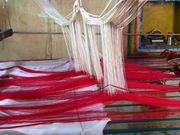

- The nivi drape starts with one end of the sari tucked into the waistband of the petticoat. The cloth is wrapped around the lower body once, then hand-gathered into even pleats just below the navel. The pleats are also tucked into the waistband of the petticoat.[12] They create a graceful, decorative effect which poets have likened to the petals of a flower.[12]
- After one more turn around the waist, the loose end is draped over the shoulder.[12] The loose end is called the pallu or pallav. It is draped diagonally in front of the torso. It is worn across the right hip to over the left shoulder, partly baring the midriff.[12] The navel can be revealed or concealed by the wearer by adjusting the pallu, depending on the social setting in which the sari is being worn. The long end of the pallu hanging from the back of the shoulder is often intricately decorated. The pallav may either be left hanging freely,tucked in at the waist, used to cover the head, or just used to cover the neck, by draping it across the right shoulder as well. Some nivi styles are worn with the pallu draped from the back towards the front.
The Nivi sari was popularised through the paintings of Raja Ravi Varma.[13] by modifying the south indian sari called mundum neriyathum. In one of his painting the Indian subcontinent was shown as a mother wearing a flowing nivi sari.[13]
Sari outside India
In Bangladesh
The sari is worn by women throughout Bangladesh. There are many regional variations of Saris in both silk and cotton. But the Jamdani Tanta/Taant cotton, Dhakai Benarosi, Rajshahi silk, Tangail Tanter sari, tashar silk, and Katan sari are the most popular in Bangladesh.
In Pakistan
In Pakistan, saris are less commonly worn than the Salwar kameez which is worn throughout the country. Because of its long association with the Hindu culture and it exposing the stomach and navel, Sari is considered to be against the injunctions of Islam and as a 'Hindu dress'.[14][15] Even though, saris have been worn by people living in the region that is now Pakistan since ancient times, it has lost popularity since 1947. Many Islamic right wing elements have pressed on a move to ban saris.[15] However, the sari remains a popular garment among the upper class for many formal functions.[16] The sari is worn as daily wear by Pakistani Hindus, by elderly Muslim women who were used to wearing it in pre-partition India[17] and by some of the new generation who have reintroduced the interest in saris.[18]
In Sri Lanka
Sri Lankan women wear saris in many styles. However, two ways of draping the sari are popular and tend to dominate; the Indian style (classic nivi drape) and the Kandyan style (or osaria' in Sinhalese). The Kandyan style is generally more popular in the hill country region of Kandy from which the style gets its name. Though local preferences play a role, most women decide on style depending on personal preference or what is perceived to be most flattering for their figure.
The traditional Kandyan (osaria) style consists of a full blouse which covers the midriff completely, and is partially tucked in at the front as is seen in this 19th century portrait. However, modern intermingling of styles has led to most wearers baring the midriff. The final tail of the sari is neatly pleated rather than free-flowing. This is rather similar to the pleated rosette used in the Dravidian style noted earlier in the article.
The Kandyan style is considered the national dress of Sinhalese women. It is the uniform of the air hostesses of Sri Lankan Airlines.
In Nepal
In Nepal, a special style of draping is used in a sari called haku patasihh. The sari is draped around the waist and a shawl is worn covering the upper half of the sari, which is used in place of a pallu.
In Israel
Every year 30,000 Israeli tourists visit India.Which is approximately 0.5 % of the entire Israeli population. Israeli tourists, ceremonially bring Indian fabrics, drsses and costumes with them. Israeli blogger Olga-Lednichenko from Haifa, Israel, has a thriving blog, not just about Indian saris, but also about Lehgha, choli and all the 16 ways of shringar. Israeli girls are a big fan of Indian "things" - especially women of slavic origins.
The sari as cloth
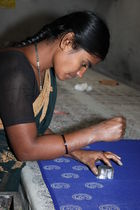
Saris are woven with one plain end (the end that is concealed inside the wrap), two long decorative borders running the length of the sari, and a one to three foot section at the other end which continues and elaborates the length-wise decoration. This end is called the pallu; it is the part thrown over the shoulder in the nivi style of draping.
In past times, saris were woven of silk or cotton. The rich could afford finely-woven, diaphanous silk saris that, according to folklore, could be passed through a finger ring. The poor wore coarsely woven cotton saris. All saris were handwoven and represented a considerable investment of time or money.
Simple hand-woven villagers' saris are often decorated with checks or stripes woven into the cloth. Inexpensive saris were also decorated with block printing using carved wooden blocks and vegetable dyes, or tie-dyeing, known in India as bhandani work.
More expensive saris had elaborate geometric, floral, or figurative ornaments or brocades created on the loom, as part of the fabric. Sometimes warp and weft threads were tie-dyed and then woven, creating ikat patterns. Sometimes threads of different colors were woven into the base fabric in patterns; an ornamented border, an elaborate pallu, and often, small repeated accents in the cloth itself. These accents are called buttis or bhuttis (spellings vary). For fancy saris, these patterns could be woven with gold or silver thread, which is called zari work.
Sometimes the saris were further decorated, after weaving, with various sorts of embroidery. Resham work is embroidery done with colored silk thread. Zardozi embroidery uses gold and silver thread, and sometimes pearls and precious stones. Cheap modern versions of zardozi use synthetic metallic thread and imitation stones, such as fake pearls and Swarovski crystals.
In modern times, saris are increasingly woven on mechanical looms and made of artificial fibers, such as polyester, nylon, or rayon, which do not require starching or ironing. They are printed by machine, or woven in simple patterns made with floats across the back of the sari. This can create an elaborate appearance on the front, while looking ugly on the back. The punchra work is imitated with inexpensive machine-made tassel trim.
Hand-woven, hand-decorated saris are naturally much more expensive than the machine imitations. While the over-all market for handweaving has plummeted (leading to much distress among Indian handweavers), hand-woven saris are still popular for weddings and other grand social occasions.
Types of saris
While an international image of the modern style sari may have been popularised by airline stewardesses, each region in the Indian subcontinent has developed, over the centuries, its own unique sari style. Following are the well known varieties, distinct on the basis of fabric, weaving style, or motif, in South Asia:
Northern styles
- Banarasi – Uttar Pradesh
- Shalu – Uttar Pradesh
Western styles
- Paithani – Maharashtra
- Bandhani – Gujarat and Rajasthan
- Kota doria Rajasthan
- Lugade – Maharashtra
- Patola – Gujarat
Central styles
- Chanderi – Madhya Pradesh
- Maheshwari – Madhya Pradesh
- Kosa silk – Chattisgarh
Southern styles
- Kanchipuram (locally called Kanjivaram) – Tamil Nadu
- Coimbatore – Tamil Nadu
- Chinnalapatti – Tamil Nadu
- Chettinad – Tamil Nadu
- Madurai – Tamil Nadu
- Arani – Tamil Nadu
- Pochampally – Andhra Pradesh (GI rights applied)[19]
- Venkatagiri – Andhra Pradesh
- Gadwal – Andhra Pradesh
- Guntur – Andhra Pradesh
- Narayanpet – Andhra Pradesh
- Mangalagiri – Andhra Pradesh
- Balarampuram – Kerala
- Mysore silk – Karnataka
- Ilkal saree – Karnataka
Eastern styles
- Tussar Silk – Bihar
- Tangail cotton – Bangladesh
- Jamdani – Bangladesh
- Dhakai Benarasi – Bangladesh
- Rajshahi Silk – Bangladesh
- Mooga silk – Assam
- Tant famous Bengali cotton – Shantipur, West Bengal
- Dhaniakhali cotton – West Bengal
- Murshidabad silk – West Bengal
- Baluchari silk – West Bengal
- Sambalpuri silk – Orissa
- Kotki (from Cuttack) – Orissa
- Ikkat (from Orissa)
Images
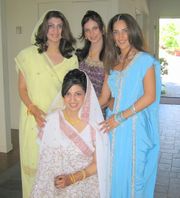 Women in saris |
 Ramanadha in sari |
 Fatima Jinnah |
 Sari Showcase at a store |
 North Indian Women in Sari by Raja Ravi Varma |
.jpg) Banarasi Sari from Baily Road, Bangladesh |
 A Sambalpuri Handloom Sari From Orissa |
 A Keralite Malayali woman dressed in a set-saree, a "quasi" - Mundum Neriyathum |
See also
- Achkan
- Dhoti
- Lungi
- Choli
- Ghoonghat
- Indian dress
- Salwar kameez
- sarong
- Churidar and Kurta
- Ghagra
- Lehenga
- Dupatta
- Wedding sari
- Lehenga Style Saree
Notes
- ↑ 1.0 1.1 1.2 1.3 1.4 Alkazi, Roshan (1983) "Ancient Indian costume", Art Heritage; Ghurye (1951) "Indian costume", Popular book depot (Bombay); Boulanger, Chantal; (1997)
- ↑ Costumes of India and Pakistan: a historical and cultural study - Shiv Nath Dar - 1969
- ↑ R. S. McGregor, ed (1997). The Oxford Hindi-English Dictionary. Oxford University Press. p. 1003. ISBN 9780198643395.
- ↑ Monier-Williams, Monier (1995). A Sanskrit-English Dictionary. Delhi: Motilal Banarsidass. p. 1063. ISBN 81-208-0065-6. http://www.sanskrit-lexicon.uni-koeln.de/monier/index.html. Retrieved 2010-07-04.
- ↑ Kapoor, Subodh (2002). The Indian encyclopaedia: biographical, historical, religious, administrative, ethnological, commercial and scientific. Reunion-Satya Yauvana, Volume 20. Genesis Publishing Pvt Ltd. p. 6422 (pg no. starts from 6130). ISBN 9788177552577. http://books.google.co.in/books?id=Ieypjy0k2TsC&pg=PA6422. "The etymology of the word sari is from the Sanskrit 'sati', which means strip of cloth. This evolved into the Prakriti 'sadi', and was later anglicised into sari"
- ↑ 6.0 6.1 Parthasarathy, R. (1993) The Tale of an Anklet: An Epic of South India – The Cilappatikaram of Ilanko Atikal, Translations from the Asian Classics, Columbia Univ. Press, New York, 1993.
- ↑ Bharata (1967). The Natyashastra [Dramaturgy], 2 vols., 2nd. ed. Trans. by Manomohan Ghosh. Calcutta: Manisha Granthalaya; Beck, Brenda. (1976) The Symbolic Merger of Body, Space, and Cosmos in Hindu Tamil Nadu. Contributions to Indian Sociology 10(2): 213-43.
- ↑ Alkazi, Roshan (1983) "Ancient Indian costume", Art Heritage
- ↑ Miller, Daniel & Banerjee, Mukulika; (2004) "The Sari", Lustre press / Roli books; Boulanger, C (1997) Saris: An Illustrated Guide to the Indian Art of Draping, Shakti Press International, New York. ISBN 0-9661496-1-0 ; Ghurye (1951) "Indian costume", Popular book depot (Bombay);
- ↑ 10.0 10.1 Ghurye (1951) "Indian costume", Popular book depot (Bombay); Boulanger, Chantal; (1997) Saris: An Illustrated Guide to the Indian Art of Draping, Shakti Press International, New York.
- ↑ Boulanger, Chantal; (1997) Saris: An Illustrated Guide to the Indian Art of Draping, Shakti Press International, New York.
- ↑ 12.0 12.1 12.2 12.3 12.4 Dongerkerry, Kamala, S. (1959) The Indian sari. New Delhi.
- ↑ 13.0 13.1 Miller, Daniel & Banerjee, Mukulika; (2004) "The Sari", Lustre press / Roli books.
- ↑ Kaul, Suvir (2001). The partitions of memory: the afterlife of the division of India. Orient Blackswan. p. 188. ISBN 9788178240138. http://books.google.co.in/books?id=UbftPfsBUZEC&pg=PA188.
- ↑ 15.0 15.1 Mumtaz, Khawar; Shaheed, Farida (1987). Women of Pakistan: two steps forward, one step back?. Zed Books. ISBN 9780862322809.
- ↑ "Bollywood, saris and a bombed train". Asia Times. http://www.atimes.com/atimes/South_Asia/IB23Df03.html. Retrieved 2007-08-31.
- ↑ "The spread of the salwar". The Hindu. http://www.hindu.com/thehindu/mag/2004/10/24/stories/2004102400380300.htm. Retrieved 2007-08-31.
- ↑ "Meanwhile: Unraveling the sari". International Herald Tribune. http://www.iht.com/articles/2005/04/27/opinion/eddatta.php.
- ↑ GI registration: Pochampally sarees set the trend The Hindu, Dec 28, 2005.
Further reading
- Ambrose, Kay (1950) Classical Dances and Costumes of India. A. & C. Black, London.
- Craddock, Norma. (1994). Anthills, Split Mothers, and Sacrifice: Conceptions of Female Power in the Mariyamman Tradition. Dissertation, U. of California, Berkeley.
External links
- Banarasi Sari Making & History
- Saree Designs, Saree classifications based on fabrics, Art Style
- Indian Sarees Article on Indian Sarees
- South Indian Sarees Article on South Indian Sarees
- Sari vs. salwar kameez on the subcontinent
- Indian sari falls from grace as urban women adopt Western styles
|
||||||||||||||||||||||||||||||||||||||||||||||||||||||||
|
|||||||||||